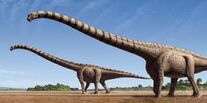Mamenchisaurus is one of the most unique long-necked dinosaurs for a very good reason - it has a really long neck. In fact, it had the longest neck of any creature that ever lived. Stretching [18 metres (59 ft)], the neck on Mamenchisaurus was longer than a school bus! The rest of it was just like other members of its family; a long tail, stout legs and really big.
gallery
[]




Corythosaurus was a hadrosaur dinosaur that lived in the Late Cretaceous period. Its name meaning "Helmet lizard". It is also known as Corinithosaurus
In the game Jurassic Park: Explorer the following information is given about this creature:
Corythosaurus had hundreds of small interlocking teeth at the back of its jaw, allowing it to crush and grind plant matter. The bony crest on top of its head contained its nasal passage and may have been used as a sounding device.
Like other duckbills and some other late Cretaceous plant-eating dinosaurs, Corythosaurus had huge numbers of teeth crammed together into "batteries" forming a single grinding surface on each side of the upper and lower jaws. This allowed the dinosaur to process large amounts of food at once. The hadrosaurines had broad, "ducklike" snouts to cut a wide swathe through the herb layer, while lambeosaurines such as Corythosaurus had narrower snouts and presumably fed more selectively.
The most distinctive feature of the lambeosaurines was the hollow bony crest on top of the head. The size and shape of these crests varied greatly. As a result, different skeletons of Corythosaurus have been identified as belonging to at least seven different species. However, comparison of more than 20 skulls has shown that the crest changes as it grows and differs between the sexes. Only a single species is, therefore, now recognized. The large-crested individuals are thought to be the adult males. They probably used the crest to intimidate others males. The skin covering the crest may have been brightly colored or patterned, and the hollow within the bone, which was connected to the airway, may have been used to produce distinctive honking calls.
gallery[]




